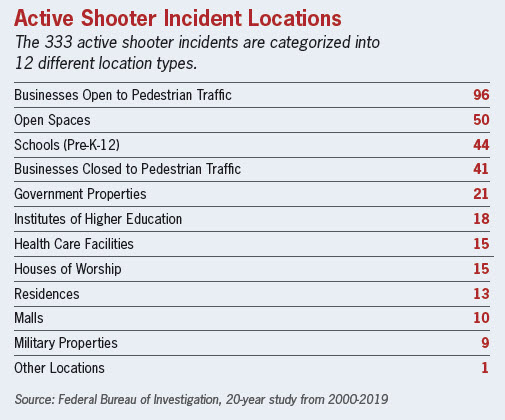
It was like any other fall day at a New Jersey automotive store when an agitated man entered the shop and headed upstairs to the office of his former girlfriend, an administrative assistant for an adjoining business. The man approached her and began an argument, then threatened her life with a gun. Employees nearby heard raised voices and threats and panicked. The store’s manager ran upstairs to help. The assailant shot him as he approached and then fired at his former girlfriend, striking her twice. The assailant then shot himself. Both victims survived.
John Matthews, PMA Senior Risk Control Consultant and former municipal police officer for 26 years, was friends with the store’s manager at the time of the incident. And even though it happened some time ago, the incident is still etched in his mind. “You couldn’t get an anymore ‘out of the way’ place,” Matthews says. “It wasn’t a main drag. It was on a dead-end street.” In addition, the office building was not open to the public. “It happened to be a domestic situation where the ex-boyfriend knew where his ex-girlfriend was going to be and he went there to do her harm,” he says.
Unfortunately, active shooter incidents are on the rise in the workplace no matter what the location. “This was a business not open to the public. Simply locking the door could have kept the intruder from heading upstairs and getting to his target,” he says. However, it is not always so clear cut.
Can It Be Avoided?
According to the Occupational Safety and Health Administration (www.osha.gov), workplace violence is any act or threat of physical violence, harassment, intimidation, or other threatening disruptive behavior that occurs at the worksite. It ranges from threats and verbal abuse to physical assaults and homicide. It can affect and involve employees, clients, customers, and visitors.
And it can happen anywhere. “No business is immune,” says Matthews. Though it seems many recent nationwide active shooter events are occurring in K-12 schools and higher education, they also occur in government facilities, public buildings, critical infrastructure, recreation facilities, healthcare facilities, commercial buildings, houses of worship, retail establishments, and at community events, among others.
Is there any hope of avoiding this type of violence? “If someone is dead set on doing something, you could have the military up front and not be able to stop a violent event from occurring. Unfortunately, there is no prevention,” Matthews says, “but we can plan.” He says if we make things harder, if we harden targets, we can make it harder for strangers to get into the building. Awareness is another factor. “Awareness of what’s happening is why reduced injuries are occurring across the country—people are more aware and better prepared than they’ve ever been.”
Considerations for Addressing Potential Workplace Violence
The first step in combatting workplace violence is identifying areas that may need to be addressed or improved in your workplace. Some considerations include:
Conduct a Vulnerability Assessment—Address the safety and security of entrances and exits at all times of the day. Are employees separated from the public with barriers? Assess stairwells, hallways, unsecured office doors or windows—any area where an intruder can get in or break in.
Tighten Security—Does your organization use sign-in logs, employee IDs with photos, key-fob systems, employee swipe cards, or smart phone apps for security purposes? Make sure security is enforced. For example, are employees letting strangers “piggyback” off employees to get through the door? Are employees alerted to visitors?
Be “Communication-Ready”—How do you communicate with employees and emergency personnel when an emergency is occurring? Do you use radios, phones, cellphones, intercoms, or code words?What are the response times of emergency personnel? Your local police department may be able to assist as a resource.
Notice Suspicious Behaviors—Any employee should alert Human Resources, management, or the police when concerning or suspicious behaviors occur.
Implement Company Policies—Human Resources and/or management should be involved in any reports of suspicious activity/unusual behaviors in the workplace and set company policies for appropriate employee behaviors. What is being done for conflict resolution in the workplace? One of the best protections employers can offer their workers is to establish a zero-tolerance policy toward workplace violence.
 Provide Emergency Evacuation Plans—Are evacuation plans posted throughout the building? Keep reminding employees in the event of a crisis, such as a fire or an act of violence, that they need to exit the building as quickly as possible. Doing drills helps employees develop “muscle memory” to quickly evacuate the building. Make sure there are plans for employees with disabilities. How does management account for the number of employees who have evacuated?
Provide Emergency Evacuation Plans—Are evacuation plans posted throughout the building? Keep reminding employees in the event of a crisis, such as a fire or an act of violence, that they need to exit the building as quickly as possible. Doing drills helps employees develop “muscle memory” to quickly evacuate the building. Make sure there are plans for employees with disabilities. How does management account for the number of employees who have evacuated?
Employee Training, Capabilities & Equipment—As you are developing your emergency plans, plan to train employees on active shooter events (situational awareness) and response. Also assess if you have employees who have had life experiences, including first responder, CPR, or military training. Are there defibrillators throughout the building? Are bleed control and first aid kits available?
According to Matthews, if you are starting from scratch in assessing the threat of workplace violence, begin by building on what you already have in place. Then continue to build out your plan, identify resources, and develop, evaluate, implement, and train employees. Your local police department may be able to provide resources in the plan development phase. You can also contact your PMA Risk Control representative for assistance. “The better prepared we are, the better we are able to respond,” he says.
Helpful Workplace Violence Resources
FEMA — Be Prepared for an Active Shooter
Planning for Disasters and Emergencies — www.ready.gov
NFPA 3000 — Standard for an Active Shooter/Hostile Event Response

Workplace Violence: Assessing the Threat (Pre-recorded Webinar)
If you have any questions or would like additional information, please contact your local PMA Risk Control Consultant or reach out to us at heretohelp@pmagroup.com.
IMPORTANT NOTICE
The information and suggestions presented by PMA Companies in this risk control technical bulletin are for your consideration in your loss prevention efforts. They are not intended to be complete or definitive in identifying all hazards associated with your business, preventing workplace accidents, or complying with any safety related or other laws or regulations. You are encouraged to alter the information and suggestions to fit the specific hazards of your business and to have your legal counsel review all of your plans and company policies. PMA Companies and Old Republic Companies do not provide legal advice and the information and suggestions in this bulletin should not be considered as such.

